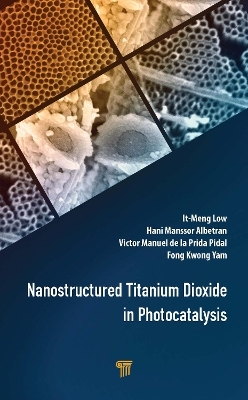
Nanostructured Titanium Dioxide in Photocatalysis
Jenny Stanford Publishing (Verlag)
978-981-4877-07-7 (ISBN)
Titanium dioxide (TiO2) has drawn considerable attention as an attractive inorganic raw material for various applications due to its inexpensiveness, nontoxic nature, stability, and excellent photocatalytic activity. Photocatalysis is one of the most promising route for sustainable chemistry of the 21st century. It can contribute to solving environmental, global energy, and chemical problems, as well as to the sustainable production of commodities in the near future.
This book presents the fundamentals of photocatalysis in nanostructured TiO2 and describes the factors affecting the photocatalytic activity, design, and synthesis of various forms of nanostructured TiO2. It highlights the use of ion-doping and inert-atmosphere annealing to extend the light-absorption range of photocatalysts and reduce recombination between electrons and holes. It discusses numerous applications in the fields of energy and environment, such as water purification, gas sensing, storage and delivery, and energy generation. The book is an invaluable resource and useful guide for a broad readership in various fields of catalysis, materials science, environment, and energy.
It-Meng Low is currently an adjunct professor of applied physics at Curtin University, Australia. He earned his PhD in materials engineering from Monash University, Australia. After completing his postdoctoral fellowship in mechanical engineering from the University of Sydney, Australia, he became a lecturer of chemical and materials engineering at the University of Auckland, New Zealand. He then moved to Curtin University as a lecturer of materials engineering and was promoted to senior lecturer, associate professor, and then full professor. He has authored or coauthored nearly 20 books and more than 190 articles in international peer-reviewed journals. Hani Manssor Albetran is an assistant professor at the Department of Basic Sciences, College of Education, Imam Abdulrahman Bin Faisal University (formerly known as University of Dammam), Saudi Arabia. He received his BSc from King Saud University, Riyadh, Saudi Arabia. He earned his MSc and PhD from Curtin University, Australia. He has also been a teacher with the Ministry of Education, a teaching assistant at King Faisal University, and a lecturer at the University of Dammam. He has authored or coauthored 27 research papers in international peer-reviewed journals. Victor Manuel de la Prida Pidal is a full professor of applied physics at the University of Oviedo, Asturias, Spain. He had earned his PhD from the same university. He has authored or coauthored 1 book, around 10 book chapters, and more than 160 research papers in journals of international repute. He has presented over 250 scientific communications in national and international conferences and has been the leading scientist in around 19 of the 25 international, national, and regional research. Fong Kwong Yam is an associate professor and chairperson of Engineering Physics program (from Jan 2017 till now) at the School of Physics, Universiti Sains Malaysia (USM), Penang, Malaysia. He received his BSc (Hons) in physics (1992) and MSc in materials science and engineering (1999) from USM and the National University of Singapore (NUS), respectively. He obtained his PhD from USM in 2007, and has been working there since then. He has authored or co-authored 1 book, 2 book chapters, and more than 250 articles in international peer-reviewed journals.
Part I: Introduction and Background 1 Introduction and Literature Review Part II: Methodologies 2 Material Synthesis and Methologies 3 Characterization Techniques Part III: Materials Characterization 4 In-situ Isothermal High-Temperature Diffraction Studies on Crystallization, Phase Transformation, and Activation Energies in Anodized Titania Nanotubes 5 Effect of Calcination on Band Gaps for Electrospun Titania Nanofibers Heated in Air–Argon Mixtures 6 Characterization and Optimization of Electrospun TiO2/PVP Nanofibers Using Taguchi Design of Experiment Method 7 Effect of Pressure on TiO2 Crystallization Kinetics Using In-situ Sealed Capillary High Temperature Synchrotron Radiation Diffraction 8 Characterization of Chemical Bath–Deposited TiO2 Thin Films 9 Electrolyte and Temperature Influence on Anodic Nanotubes Part IV: Materials Properties and Applications 10 Phase Transformations and Crystallisation Kinetics of Electronspun TiO2 Nanofibers in Air and Argon Atmospheres 11 Effect of Vanadium Ion Implantation on the Crystallization Kinetics and Phase Transformation of Electrospun TiO2 Nanofibers 12 A Comparative Study of Crystallization Behaviour, Phase Stability, and Binding Energy in Pure and Cr-Doped TiO2 Nanotubes 13 Effect of Indium Ion Implantation on Crystallization Kinetics and Phase Transformation of Anodized Titania Nanotubes 14 Ni Nanowires Grown in Anodic TiO2 Nanotube Arrays As Diluted Magnetic Semiconductor Nanocomposites 15 Applications of Nanostructured TiO2 Part V: Conclusions 16 Summary and Conclusions
| Erscheinungsdatum | 21.06.2021 |
|---|---|
| Zusatzinfo | 21 Tables, black and white; 21 Illustrations, color; 76 Illustrations, black and white |
| Sprache | englisch |
| Maße | 152 x 229 mm |
| Gewicht | 660 g |
| Themenwelt | Naturwissenschaften ► Biologie |
| Naturwissenschaften ► Physik / Astronomie ► Festkörperphysik | |
| Technik ► Elektrotechnik / Energietechnik | |
| Technik ► Maschinenbau | |
| Technik ► Umwelttechnik / Biotechnologie | |
| ISBN-10 | 981-4877-07-7 / 9814877077 |
| ISBN-13 | 978-981-4877-07-7 / 9789814877077 |
| Zustand | Neuware |
| Haben Sie eine Frage zum Produkt? |
aus dem Bereich


